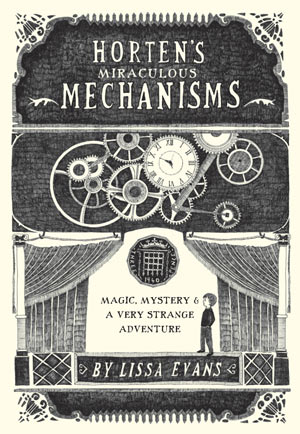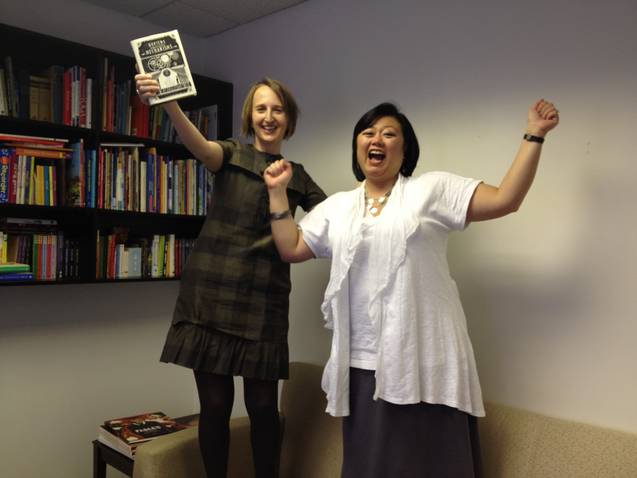 After four years of being a physician, Lissa Evans gave it up. She thought, "What do I do now?" She'd written and produced comedy in college, so she went to radio and then to television comedy as a script editor and producer. Then, "after years of running a red pencil through other people's work," she said with a laugh, she started writing at age 39.
After four years of being a physician, Lissa Evans gave it up. She thought, "What do I do now?" She'd written and produced comedy in college, so she went to radio and then to television comedy as a script editor and producer. Then, "after years of running a red pencil through other people's work," she said with a laugh, she started writing at age 39.
Your first books were for adults. What made you want to write a children's book?
The books I loved best as a child were books like The Diamond in the Window by Jane Langton. I liked magic in real life rather than magical kingdoms. When I was nine, we moved house near the beginning of the summer holidays. I was the youngest by a long way. I spent a great deal of time alone, wishing desperately that something magical would happen. I started adopting objects that I thought could be magical--a grandfather clock and a little back alley with a robin in it. I wanted something to take me into a magical world. I wanted to write a book like that, a book of possibilities.
Did you conceive of this as a series, or did that evolve as you got deeper into the story?
I started with Stuart's story and just kept going. Initially I wrote a cliffhanger. I think I realized about halfway through, he'd just discovered the workshop and you can't end there. This will be two books only.
Did your background in comedy help with the pacing?
I think maybe it does. I've written books for adults, but you write those in a different way, and you certainly don't end them on cliffhangers. You can get away with a so-so description, but a joke has to be exactly right. Similarly, with the accuracy of description of suspense, you have to get the phrasing exactly right or it doesn't do what you want it to do. It's got to be tight pacing and no flabbiness.
One of the book's strong themes is the importance of paying attention. Uncle Tony originally intended to leave clues for Stuart's father, but Stuart's the one who figures them out. Yet his father gives Stuart valuable information, too.
I couldn't just have the father as a comic figure. His function is to pick up on the things Stuart wouldn't. He's often quite useful. There's teamwork, though it's not conscious on the father's part. It's classic old-married-couple comedy. There's more of it in the next book.
The clues to your mystery stay firmly planted in a child's experience. For instance, one key clue is that Stuart has to figure out what a baker's dozen is.
Children can appreciate slapstick and sarcasm, but it has to be in the realm of their experience. I think, "What wouldn't I quite have understood then, which bit would I have needed adult help for?" You have to crouch down mentally and approach it from a child's viewpoint.
Stuart enters the mystery by coincidence, by picking up the phone in the telephone booth that he later recognizes from the book of photographs.
That came as I wrote it. I'm not somebody who does all the plot in advance, which meant the natural twists and turns are quite natural because that's how I think of them. I'll write a character in and then realize how useful they might be in the future. The book of photographs came as a thought later. I do love my plots to tie up.
We loved the triplets, and how April rises to the top.
I've always been obsessed with twins, and I have 10-year-old twin girls. Not identical, they're completely different. I kind of always loved the idea of having someone always there. Two of my three adult books have twins. I never put them in deliberately, but they sort of turn up in things.
Even though April plays the larger role, you don't waste May and June--they serve a purpose later in the novel.
I didn't want to shortchange the triplets. There's much more to them in the second book. "You don't have to like them, you just have to tolerate them, that's what I do," says April in the second book. April is the kind of girl I was. If I was in the book, I would have done just what April does. I love that she's a glasses wearer but still a daredevil.
One of our favorite things about Uncle Tony is that he doesn't believe in magic per se; he believes in the mechanisms he invents that create the illusion of magic.
I love the bit where April says, "I don't believe in magic." Stuart says, "Neither do I, and neither did Uncle Tony." It's one where people stumble across it and have to embrace magic because it's there. I believed in magic so strongly as a child. This is kind of wish fulfillment.
Can you give us a hint of what's coming in the second and final book?
Each of the tricks comes into its own in the next book, and each has an adventure of its own. It's funny because I wrote the names of the tricks in passing--they're not important in the first book--but they become important in the second book.
Time travel introduces a bit of complexity, doesn't it? Do you like time loop puzzles?
There's an aspect of time travel in the next book, but perhaps not what you think. I'm a believer in the idea that "We'll never invent time travel because no one's ever come back to see us." I do like my explanations; I like to know why things have happened. If I can buy it, I enjoy it, but if it's just "I feel shivery; I'm back in Victorian times," I'll pass.







 In her first book for young readers, Lissa Evans (Their Finest Hour and a Half) combines mystery, comedy and a charming hero in a page-turning middle-grade novel. Her background as a comedy show producer shines through in the impeccable timing of the well-planted clues and sudden revelations--often delivered with a dash of humor.
In her first book for young readers, Lissa Evans (Their Finest Hour and a Half) combines mystery, comedy and a charming hero in a page-turning middle-grade novel. Her background as a comedy show producer shines through in the impeccable timing of the well-planted clues and sudden revelations--often delivered with a dash of humor. Meanwhile, the neighbor girl keeps following him! How can she be so omnipresent? Stuart soon discovers it's because she is really three--identical triplets April, May and June Kingley. And April (who distinguishes herself from her siblings by wearing glasses) turns out to be quite helpful to Stuart on his mission--especially when Stuart's parents decide to take a family camping trip the weekend before Uncle Tony's house is to be demolished.
Meanwhile, the neighbor girl keeps following him! How can she be so omnipresent? Stuart soon discovers it's because she is really three--identical triplets April, May and June Kingley. And April (who distinguishes herself from her siblings by wearing glasses) turns out to be quite helpful to Stuart on his mission--especially when Stuart's parents decide to take a family camping trip the weekend before Uncle Tony's house is to be demolished.
 After four years of being a physician, Lissa Evans gave it up. She thought, "What do I do now?" She'd written and produced comedy in college, so she went to radio and then to television comedy as a script editor and producer. Then, "after years of running a red pencil through other people's work," she said with a laugh, she started writing at age 39.
After four years of being a physician, Lissa Evans gave it up. She thought, "What do I do now?" She'd written and produced comedy in college, so she went to radio and then to television comedy as a script editor and producer. Then, "after years of running a red pencil through other people's work," she said with a laugh, she started writing at age 39.  Everyone at Sterling loved the book. The only caveat was "everyone kept asking me if this were another Stuart Little book," Loh said. "When we noodled it around, we decided the crux of the book was the mechanisms, and that's how the title came about: Horten's Miraculous Mechanisms." In the next book, Horten's Incredible Illusions, each of Teeny-Tiny Tony Horten's magic tricks (named in the first book) gets its own adventure. "We think this is a book that the whole family will enjoy," said Gilbert. "Stuart's relationship with his parents is so loving and smart."
Everyone at Sterling loved the book. The only caveat was "everyone kept asking me if this were another Stuart Little book," Loh said. "When we noodled it around, we decided the crux of the book was the mechanisms, and that's how the title came about: Horten's Miraculous Mechanisms." In the next book, Horten's Incredible Illusions, each of Teeny-Tiny Tony Horten's magic tricks (named in the first book) gets its own adventure. "We think this is a book that the whole family will enjoy," said Gilbert. "Stuart's relationship with his parents is so loving and smart." On your nightstand now:
On your nightstand now: